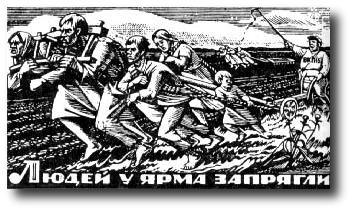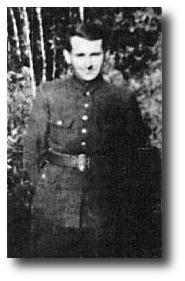![[LITOPYS UPA: Chronicle of the Ukrainian Insurgent Army]](/upa/images/litopys.jpg)
SERIES 1
VOLUME 28
![[LITOPYS UPA: Chronicle of the Ukrainian Insurgent Army]](/upa/images/litopys.jpg)

 Maria Savchyn's memoirs differ in many ways from other memoirs about
the UPA struggle. The author spent more than nine years in the
underground, from 1944, almost from the inception of the armed
struggle, to the summer of 1953, when only the "last Mohicans" of the
underground remained. During these years she lived in the Lviv area,
Zakerzonnia (Ukrainian ethnic territory in Poland), Poland, the
Carpathian Mountains, Podillia, Volyn and Polissia and in her memoirs
she describes her experiences in all these regions. In addition, from
1945, she was married to Vasyl Halasa, who served first as the Deputy
leader of the OUN in Zakerzonnia, then, from 1948, as the OUN leader
for North-Western Ukraine (Volyn and Polissia). She was with her
husband most of this time, met many leading personalities and typed up
letters, reports, recommendations, instructions and other materials
for them. She saw and knew a lot and this fact is reflected in her
memoirs.
Maria Savchyn's memoirs differ in many ways from other memoirs about
the UPA struggle. The author spent more than nine years in the
underground, from 1944, almost from the inception of the armed
struggle, to the summer of 1953, when only the "last Mohicans" of the
underground remained. During these years she lived in the Lviv area,
Zakerzonnia (Ukrainian ethnic territory in Poland), Poland, the
Carpathian Mountains, Podillia, Volyn and Polissia and in her memoirs
she describes her experiences in all these regions. In addition, from
1945, she was married to Vasyl Halasa, who served first as the Deputy
leader of the OUN in Zakerzonnia, then, from 1948, as the OUN leader
for North-Western Ukraine (Volyn and Polissia). She was with her
husband most of this time, met many leading personalities and typed up
letters, reports, recommendations, instructions and other materials
for them. She saw and knew a lot and this fact is reflected in her
memoirs.
 An important feature of her memoirs is that they are written by a
woman and in a completely forthright manner. The author openly
describes her personal experiences and those of her closest women
friends. She lived in constant danger and frequently experienced
dramatic and tragic situations, when not only her personal fate, but
the fate of her closest friends were in danger. She experienced her
greatest tragedy in Poland, when she was obliged to leave her son with
the police. She provides a detailed description of women in the
underground, their daily joys and troubles and their thoughts and
feelings in the face of mortal danger. Her story is the life path of a
whole generation of people who made a conscious choice to serve their
nation regardless of the difficulties and dangers, who for many years
had sacrificed their lives in almost a hopeless situation.
An important feature of her memoirs is that they are written by a
woman and in a completely forthright manner. The author openly
describes her personal experiences and those of her closest women
friends. She lived in constant danger and frequently experienced
dramatic and tragic situations, when not only her personal fate, but
the fate of her closest friends were in danger. She experienced her
greatest tragedy in Poland, when she was obliged to leave her son with
the police. She provides a detailed description of women in the
underground, their daily joys and troubles and their thoughts and
feelings in the face of mortal danger. Her story is the life path of a
whole generation of people who made a conscious choice to serve their
nation regardless of the difficulties and dangers, who for many years
had sacrificed their lives in almost a hopeless situation.
The memoirs were written not long after the author made her way to the west. Her memory was still fresh and the images clear, her consciousness not yet being burdened with new experiences and the positive and negative influences of life in the free world. She felt obliged to write her memoirs, she states in the introduction, because of her sense of duty towards her comrades who had recently been with her, burning with the idea of liberating their unhappy nation and bravely overcoming the greatest obstacles only to fall on the field of battle. Frequently, the enemy would take their corpses and bury them in secret, so that no trace would remain of these fighters for the freedom of Ukraine. The author felt that she had to write about them, to ensure that the memory of their achievements and sacrifices would not fade, to pass on to future generation the message of service and sacrifice for one's nation. The memoirs also straw us the attitude and philosophy of the author at the time of writing.
The memoirs are written in the first person in the style of a novel, with numerous dialogues and other features of that genre. Although the recreated dialogues cannot be regarded as completely authentic, the author uses them judiciously to liven up the account. In any case, as the memoirs are written from fresh memory, the dialogues can be assumed to recreate real conversations. In terms of exposition, style, terminology and vocabulary, the memoirs show the influence of the underground publications for which the author was accustomed to writing. We regard this as a positive feature, because it leads to an accurate recreation of the underground style, atmosphere and way of life.
 The editorial role in preparing this memoirs for print has been
minimal. The editors helped pinpoint or identify some events and
underground activists, standardize underground names and arrange the
technical aspects of book publication. However, the author herself
read the proofs, prepared the index and checked the page make-up. For
this purpose, she twice traveled to L'viv, where the book was being
prepared for print. The pictures published in the book come from the
author and the "Litopys UPA" archives, the Volyn oblast Security
Service of Ukraine and others.
The editorial role in preparing this memoirs for print has been
minimal. The editors helped pinpoint or identify some events and
underground activists, standardize underground names and arrange the
technical aspects of book publication. However, the author herself
read the proofs, prepared the index and checked the page make-up. For
this purpose, she twice traveled to L'viv, where the book was being
prepared for print. The pictures published in the book come from the
author and the "Litopys UPA" archives, the Volyn oblast Security
Service of Ukraine and others.
In the name of the author and the Litopys UPA editors I thank everyone who contributed to this volume. First of all, i thank the financial supporter of this volume, Dmytro Hayduk, who gave $25,000 for its publication. I also thank Antin Ivakhniuk for linguistic editing, Zonia Keywan for translation, Peter J. Potichnyj for his valuable advise, the Litopys UPA collaborators in Lviv, Volodymyr Chornovus, Ihor Hrynda and others, and the Litopys UPA workers in Toronto for their help in the publication of this volume.
Yevhen Shtendera